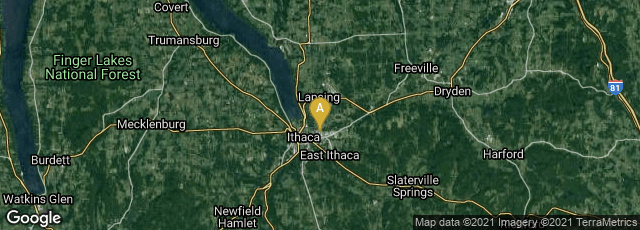

A: Ithaca, New York, United States
The Voyager Golden Records were included on the Voyager 1 and 2 spacecraft launched in on September 5, 1977 and August 20, 1977 respectively as a kind of time capsule intended to communicate a story of our world to extraterrestrials. Each was a 12-inch gold-plated copper disk-shaped phonograph record containing sounds and images selected to portray the diversity of life and culture on Earth. The contents of the record were selected for NASA by a committee chaired by Carl Sagan of Cornell University. Sagan and associates assembled 115 images and a variety of natural sounds, such as those made by surf, wind and thunder, birds, whales, and other animals. To this they added musical selections from different cultures and eras, and spoken greetings from in fifty-five languages, and printed messages from President Jimmy Carter and U.N. Secretary General Kurt Waldheim.
Because it was believed that the Voyager spacecrafts would not encounter another solar system for 40,000 years, the production of these records seems to have involved a naive faith in the permanence of accessibility of analog data, and in the durability of such data to survive over extremely long periods of time.
"Each record is encased in a protective aluminum jacket, together with a cartridge and a needle. Instructions, in symbolic language, explain the origin of the spacecraft and indicate how the record is to be played. The 115 images are encoded in analog form. The remainder of the record is in audio, designed to be played at 16-2/3 revolutions per minute. It contains the spoken greetings, beginning with Akkadian, which was spoken in Sumer about six thousand years ago, and ending with Wu, a modern Chinese dialect. Following the section on the sounds of Earth, there is an eclectic 90-minute selection of music, including both Eastern and Western classics and a variety of ethnic music. Once the Voyager spacecraft leave the solar system (by 1990, both will be beyond the orbit of Pluto), they will find themselves in empty space. It will be forty thousand years before they make a close approach to any other planetary system. As Carl Sagan has noted, 'The spacecraft will be encountered and the record played only if there are advanced spacefaring civilizations in interstellar space. But the launching of this bottle into the cosmic ocean says something very hopeful about life on this planet' (http://voyager.jpl.nasa.gov/spacecraft/goldenrec.html, accessed 02-27-2011).